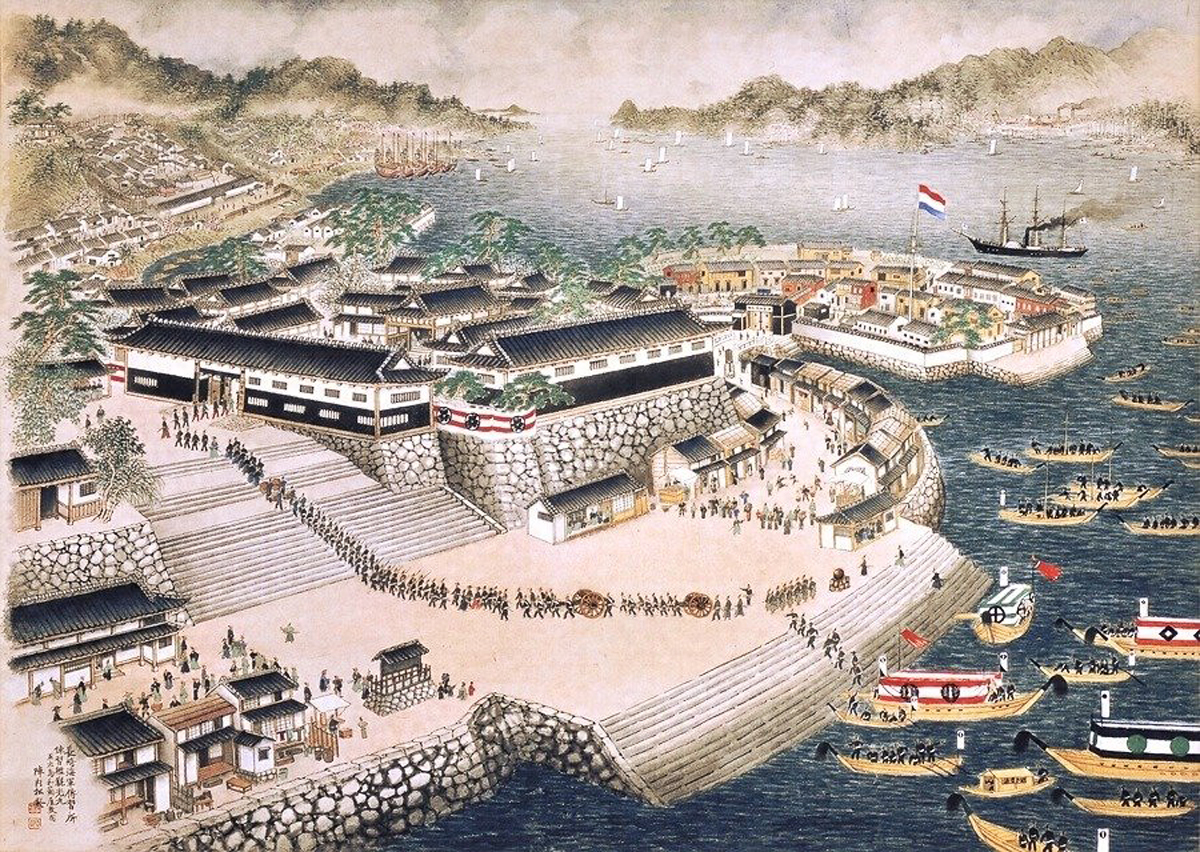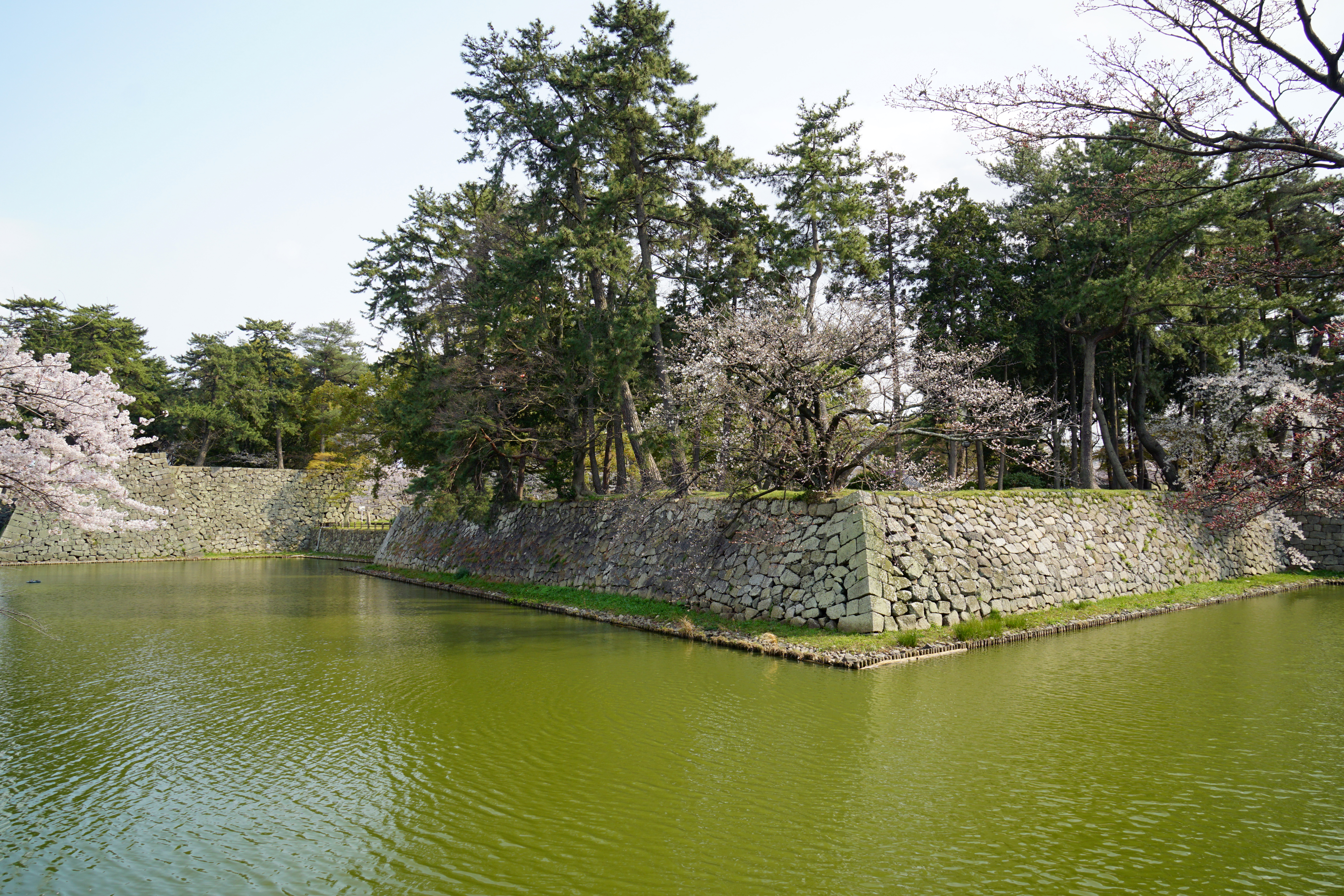|
Nagasaki Naval Training Center
The was a naval training institute, between 1855 when it was established by the government of the Tokugawa shogunate, until 1859, when it was transferred to Tsukiji in Edo. During the Bakumatsu period, the Japanese government faced increasing incursions by ships from the Western world, intent on ending the country's two centuries of isolationist foreign policy. These efforts cumulated in the landing of United States commodore Matthew Perry in 1854, resulting in the Treaty of Kanagawa and the opening of Japan to foreign trade. The Tokugawa government decided to order modern steam warships and to build a naval training center as part of its modernization efforts to meet the perceived military threat posed by the more advanced Western navies. History The training center was established near the Dutch settlement on the artificial island Dejima in Nagasaki, where maximum interaction with Dutch naval technology would be possible. Nagai Naoyuki was appointed the first director with a ... [...More Info...] [...Related Items...] OR: [Wikipedia] [Google] [Baidu] |
Fukuoka Domain
was a Japanese domain of the Edo period. It was associated with Chikuzen Province in modern-day Fukuoka Prefecture on the island of Kyushu. The domain was also sometimes referred to as Chikuzen Domain, or as Kuroda Domain, after the ruling Kuroda family. In the han system, Fukuoka was a political and economic abstraction based on periodic cadastral surveys and projected agricultural yields. In other words, the domain was defined in terms of ''kokudaka'', not land area. This was different from the feudalism of the West. With its rating of 473,000 koku, the domain was the fifth-largest in Japan, excluding the domains held by the Tokugawa-Matsudaira dynasty. List of ''daimyōs'' The hereditary ''daimyōs'' were head of the clan and head of the domain. Kuroda clan, 1600–1868 ('' tozama''; 502,000→412,000→433,000→473,000 ''koku'') # Nagamasa #Tadayuki #Mitsuyuki #Tsunamasa #Nobumasa #Tsugutaka #Haruyuki #Harutaka #Naritaka #Narikiyo # Nagahiro # Nagatomo #Prince Arisug ... [...More Info...] [...Related Items...] OR: [Wikipedia] [Google] [Baidu] |
William III Of The Netherlands
William III (Dutch: ''Willem Alexander Paul Frederik Lodewijk''; English: ''William Alexander Paul Frederick Louis''; 19 February 1817 – 23 November 1890) was King of the Netherlands and Grand Duke of Luxembourg from 1849 until his death in 1890. He was also the Duke of Limburg from 1849 until the abolition of the duchy in 1866. William was the son of King William II and Anna Pavlovna of Russia. On the abdication of his grandfather William I in 1840, he became the Prince of Orange. On the death of his father in 1849, he succeeded as king of the Netherlands. William married his cousin Sophie of Württemberg in 1839 and they had three sons, William, Maurice, and Alexander, all of whom predeceased him. After Sophie's death in 1877 he married Emma of Waldeck and Pyrmont in 1879 and they had one daughter Wilhelmina, who succeeded William to the Dutch throne. Meanwhile, being the last agnatic dynastic descendant of Otto I, Count of Nassau, the throne of the Grand Duchy of Luxembou ... [...More Info...] [...Related Items...] OR: [Wikipedia] [Google] [Baidu] |
Kankō Maru
was a after '' Chōhō'' and before ''Chōwa.'' This period spanned the years from July 1004 through December 1012. The reigning emperors were and . Change of Era * 1004 : The era name was changed to mark an event or series of events. The previous era ended and a new one commenced in ''Kankō'' 6, on the 20th day of the 7th month of 1004. Events of the ''Kankō'' Era * March 17, 1008 (''Kankō 5, 8th day of the 2nd month''): The former-Emperor Kazan died at the age of 41. * July 16, 1011 (''Kankō 8, 13th day of the 6th month''): In the 5th year of Emperor Ichijō's reign (一条天皇5年), he abdicated; and the succession (‘‘senso’’) was received by his cousin. Shortly thereafter, Emperor Sanjō is said to have acceded to the throne (‘‘sokui’’). * July 15, 1011 (''Kankō 8, 22nd day of the 6th month ''): ''Daijō-tennō'' Ichijō died at the age of 32. * November 21, 1011 (''Kankō 8, 24th day of the 10th month''): ''Daijō-tennō'' Reizei, who was E ... [...More Info...] [...Related Items...] OR: [Wikipedia] [Google] [Baidu] |
Rangaku
''Rangaku'' (Kyūjitai: /Shinjitai: , literally "Dutch learning", and by extension "Western learning") is a body of knowledge developed by Japan through its contacts with the Dutch enclave of Dejima, which allowed Japan to keep abreast of Western technology and medicine in the period when the country was closed to foreigners from 1641 to 1853 because of the Tokugawa shogunate's policy of national isolation (sakoku). Through Rangaku, some people in Japan learned many aspects of the scientific and technological revolution occurring in Europe at that time, helping the country build up the beginnings of a theoretical and technological scientific base, which helps to explain Japan's success in its radical and speedy modernization following the forced American opening of the country to foreign trade in 1854. History The Dutch traders at Dejima in Nagasaki were the only Europeans tolerated in Japan from 1639 until 1853 (the Dutch had a trading post in Hirado from 1609 till 1641 bef ... [...More Info...] [...Related Items...] OR: [Wikipedia] [Google] [Baidu] |
Willem Huyssen Van Kattendijke
Willem Johan Cornelis, Ridder Huijssen van Kattendijke (22 January 1816 – 6 February 1866) was a career officer of the Royal Dutch Navy and a politician. As an officer, he reached the rank of Commander. He was Dutch Naval Minister from 1861 to 1866, and interim Dutch Foreign Minister in 1864. Biography van Kattendijke was born in Princenhage, Netherlands, as the son of Jan Willem Huyssen van Kattendijke, foreign minister of the Netherlands from 1841 to 1843. He entered the Royal Dutch Navy, becoming a midshipman in 1831, and attended the KIM (Royal Naval Institute) in Medemblik from 1831 to 1839. He became a lieutenant 2nd class in 1839 and served on various vessels until 1842. From 1842 to 1846, he was adjutant to the Director-General of the Navy, and aide to the Minister of the Navy from 1846 to 1849, and as an aide to King William III of the Netherlands from 1846 to 1851. He was promoted to lieutenant-commander 1st class in January 1851. In 1859, van Kattendijke repla ... [...More Info...] [...Related Items...] OR: [Wikipedia] [Google] [Baidu] |
Pels Rijcken
Gerhard Christiaan Coenraad (Gerrit) Pels Rijcken (10 January 1810 – 2 May 1889) was a career officer of the Royal Dutch Navy and a politician. As an officer, Pels Rijcken reached the rank of Vice-Admiral. He was Dutch Navy Minister from 1866 to 1868. Biography Pels Rijcken was born in Princenhage, Netherlands, where his father was sheriff as well as an alderman of nearby Breda. His brother later became mayor of Arnhem (1874-1844). He entered the Royal Dutch Navy, becoming a midshipman in 1826, and rose through the ranks by serving on several vessels. He became a lieutenant, 2nd class in April 1831 and was promoted to lieutenant, 1st class in December 1845. He served as a training officer at the KIM (Royal Naval Institute) in Medemblik from 1847. From 1855 to 1857, Pels Rijcken was assigned as commandant of the Nagasaki Naval Training Center, teaching the principles of a modern naval science (navigation, cannonry, ship-handling) to samurai including Katsu Kaishu. He arrived ... [...More Info...] [...Related Items...] OR: [Wikipedia] [Google] [Baidu] |
Royal Dutch Navy
The Royal Netherlands Navy ( nl, Koninklijke Marine, links=no) is the naval force of the Kingdom of the Netherlands. During the 17th century, the navy of the Dutch Republic (1581–1795) was one of the most powerful naval forces in the world and played an active role in the Anglo-Dutch Wars, the Franco-Dutch War, and wars against Spain and several other European powers. The Batavian Navy of the later Batavian Republic (1795–1806) and Kingdom of Holland (1806–1810) played an active role in the Napoleonic Wars, though mostly dominated by French interests. After the establishment of the modern Kingdom of the Netherlands, it served an important role in protecting Dutch colonial rule, especially in Southeast Asia, and would play a minor role in World War II, especially against the Imperial Japanese Navy. Since World War II, the Royal Netherlands Navy has taken part in expeditionary peacekeeping operations. Bases The main naval base is in Den Helder, North Holland. Secondary nav ... [...More Info...] [...Related Items...] OR: [Wikipedia] [Google] [Baidu] |
Katsu Kaishū
Count , best known by his nickname , was a Japanese statesman and naval engineer during the late Tokugawa shogunate and early Meiji period. Kaishū was a nickname which he took from a piece of calligraphy (Kaishū Shooku ) by Sakuma Shōzan. He went through a series of given names throughout his life; his childhood name was . He was often called from his title during the late Tokugawa shogunate and later changed his name to Yasuyoshi after the Meiji Restoration. Katsu Kaishū eventually rose to occupy the position of commissioner ''(Gunkan-bugyō)'' in the Tokugawa navy. He is particularly known for his role in the surrender of Edo. Early life Born Katsu Yoshikuni on March 12, 1823, in Edo to a low-ranking retainer of the Tokugawa ''shōgun''. His father, Katsu Kokichi, the subject of the autobiography, '' Musui's Story'', was the ill-behaved head of a minor ''samurai'' family. As a youth whose given childhood name as Katsu Rintarō (Kaishu was a pseudonym), he studied Dut ... [...More Info...] [...Related Items...] OR: [Wikipedia] [Google] [Baidu] |
Kakegawa Domain
was a feudal domain under the Tokugawa shogunate of Edo period Japan. The domain was centered at Kakegawa Castle in Tōtōmi Province, in what is now the city of Kakegawa, Shizuoka."Tōtōmi Province" at JapaneseCastleExplorer.com retrieved 2013-7-29. History During the , Kakegawa was a fortified settlement of the . Following the defeat of the Imagawa at the hands of |
Fukuyama Domain
was a Japanese domain of the Edo period. It was associated with Bingo Province and Bitchū Province in modern-day Hiroshima Prefecture.">DF_39-40_of_80">"Mizuno"_at_''Nobiliare_du_Japon'',_pp._35–36_[PDF_39-40_of_80/nowiki>_retrieved_2013-4-28. #Katsunari #Katsutoshi #Katsusada #Katsutane #Katsumine * .html"_;"title="DF_39-40_of_80">"Mizuno"_at_''Nobiliare_du_Japon'',_pp._35–36_[PDF_39-40_of_80/nowiki>">DF_39-40_of_80">"Mizuno"_at_''Nobiliare_du_Japon'',_pp._35–36_[PDF_39-40_of_80/nowiki>_retrieved_2013-4-28. #Katsunari #Katsutoshi #Katsusada #Katsutane #Katsumine *Tokugawa_shogunate">Tenryō,_1698–1700. *Matsudaira_clan.html" ;"title="Tokugawa_shogunate.html" "title="DF_39-40_of_80/nowiki>.html" ;"title="DF 39-40 of 80">"Mizuno" at ''Nobiliare du Japon'', pp. 35–36 [PDF 39-40 of 80/nowiki>">DF 39-40 of 80">"Mizuno" at ''Nobiliare du Japon'', pp. 35–36 [PDF 39-40 of 80/nowiki> retrieved 2013-4-28. #Katsunari #Katsutoshi #Katsusada #Katsutane #Katsumine *Tokug ... [...More Info...] [...Related Items...] OR: [Wikipedia] [Google] [Baidu] |
Tsu Domain
was a feudal domain under the Tokugawa shogunate of Edo period Japan, located in Ise Province and in Iga Province in what is part of now modern-day Tsu, Mie. It was centered around Tsu Castle. Tsu Domain was controlled the '' tozama'' Tōdō clan throughout most of its history. History Tsu was known as "Anotsu" during the Sengoku period and was controlled by the Kudo clan, who were originally from Shinano Province. Oda Nobunaga's invasion of Ise in 1568 was resolved by the Kudo clan adopting Nobunaga's younger brother, Oda Nobukane as heir. Following Nobunaga's death, Nobukane swore fealty to Toyotomi Hideyoshi, but in 1594 he was transferred to Ōmi Province. Hideyoshi assigned the territory to Tomita Tomonobu, with a ''kokudaka'' of 50,000 ''koku''. On his death in 1599, he was succeeded by his son, Tomita Nobutaka, who approached Tokugawa Ieyasu. He assisted Ieyasu in the invasion of Aizu, but was later defeated at the Battle of Aonutsu Castle by a pro-Toyotomi coalition. ... [...More Info...] [...Related Items...] OR: [Wikipedia] [Google] [Baidu] |







